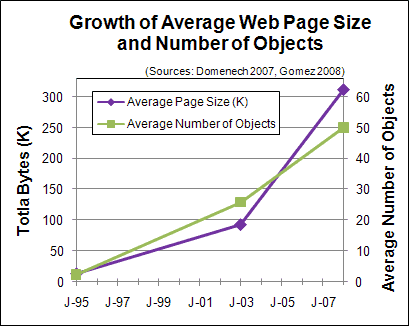Website Optimization: Average Web Page Size Triples Since 2003
April 30, 2008 (PRLEAP.COM) Technology News
Website Optimization is announcing that the size of the average web page has more than tripled since 2003. From 2003 to 2008 the average web page grew from 93.7K to over 312K (see Figure 1), some 233% (Domenech et al. 2007, Flinn & Betcher 2008). During the same five-year period, the number of objects in the average web page nearly doubled from 25.7 to 49.9 objects per page. Longer term statistics show that since 1995 the size of the average web page has increased by 22 times, and the number of objects per page has grown by 21.7 times. See Figure 1: Growth of the Average Web Pagehttp://www.websiteoptimization.com/speed/tweak/average-web-page/
Growth of the Top 1000 Web Pages in 2007
Over the past calendar year, the thousand most popular home pages grew by 24.2% from December 2006 to December 2007, that is, from 250K to 310.4K (see Figure 2). At this growth rate the average home page will exceed 385K by the end of 2008.
See Figure 2: Growth of the Average Top 1000 Home Page
http://www.websiteoptimization.com/speed/tweak/average-web-page/
The number of objects grew by 14.5% in 2007 from 44.2 in December 2006 to 50.6 objects per page in December 2007. An October 2007 survey of the top 50 retailers revealed that the average number of objects per page was 60.5 (Flinn & Betcher 2007). With the average number of objects per page above 50, the latency due to object overhead now dominates most web page delays.
Response Time Trends - The Bandwidth Divide
From 2003 to 2008 web page size has more than tripled and the number of external objects has nearly doubled. So narrowband users (56K and ISDN) have experienced slower response times over time. Conversely, broadband users have experienced somewhat faster response times over time. For broadband users the average download time of the Keynote Business 40 Internet Performance Index (KB40) has decreased from 2.8 to 2.33 seconds from Feb. 2006 to Feb. 2008 (see Figure 3 and Berkowitz & Gonzalez 2008).
Figure 3: Average KB40 Web Site Performance over Broadband from Feb. 2006 to Feb. 2008
http://www.websiteoptimization.com/speed/tweak/average-web-page/
So the increase in the average speed of broadband has more than kept pace with the increase in the size and complexity of the average web page. That is one reason why broadband users expect faster response times. Yet narrowband users have experienced slower response times as web page size has increased.
For the full press release visit:
http://www.websiteoptimization.com/speed/tweak/average-web-page/
About Website Optimization
Don't Make Me Wait! The new book titled "Speed Up Your Site – Web Site Optimization" by Andy King, and the companion web site are about designing "speedy" web sites with techniques that…
* Cut file size and download times in half
* Speed up site load time to satisfy customers
* Engage users with fast response times and flow stimulus
* Increase usability, boost profits, and slash bandwidth costs
* Improve search engine rankings and web page conversions
Andy King is also the founder of WebReference.com and JavaScript.com, both award-winning developer sites from internet.com. Created in 1995 and subsequently acquired by Mecklermedia (now Jupitermedia) in 1997, WebReference has grown into one of the most popular developer sites on the Internet. While he was Managing Editor of WebReference.com and JavaScript.com, Andy became the "Usability Czar" at internet.com, where he optimized the speed and usability of their sites. In addition to his consulting work, he continues to write the monthly Bandwidth Report and the “Speed Tweak of the Week” for WebsiteOptimization.com
